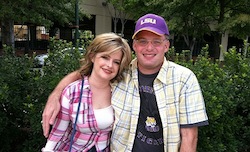IL Guest Blog: The IL Movement and CILs
Amy Kantoff
Texas Association of Independent Living Centers (TACIL)
Aug. 12, 2014
 The independent living (IL) movement in the US has had a direct impact on my family’s quality of life. My younger brother, Jay (left, with Amy), was born with an intellectual disability in the early 1970’s. If he had been born decades earlier, his life might have been very different from how it is now. He lives in his own home. He works at a place where some of his coworkers have disabilities, some don’t. Once a fearful, nonverbal kid, Jay is now a very social guy who isn’t afraid to try new things. He meets new people with confidence and makes friends easily. The relationships he’s built at work and through his art classes make for a version of Jay that we didn’t know was possible when he was younger. This transformation only took place because we had the involvement and assistance from people who practiced the IL philosophy.
The independent living (IL) movement in the US has had a direct impact on my family’s quality of life. My younger brother, Jay (left, with Amy), was born with an intellectual disability in the early 1970’s. If he had been born decades earlier, his life might have been very different from how it is now. He lives in his own home. He works at a place where some of his coworkers have disabilities, some don’t. Once a fearful, nonverbal kid, Jay is now a very social guy who isn’t afraid to try new things. He meets new people with confidence and makes friends easily. The relationships he’s built at work and through his art classes make for a version of Jay that we didn’t know was possible when he was younger. This transformation only took place because we had the involvement and assistance from people who practiced the IL philosophy.
At the moment Jay was diagnosed with an intellectual disability, the IL movement in the U.S. was gaining momentum. The leaders of the IL movement weren't organizing based on the impairments they had, but because they faced shared barriers that wouldn’t budge without sustained, collective effort. People with disabilities across the country were speaking up about issues society had created that were affecting their lives: where they lived, how they lived, and what they had access to. There was the threat of institutional bias: people like my brother, who were fully capable of living independently, were needlessly placed in institutions. We were fortunate to grow up during a time when people with all types of disabilities were organizing to fight that bias and promote equal opportunity.
---
In the early 70s, these organizers created Centers for Independent Living (CILs), designed as the hubs for change in social relations through philosophy and a practical approach through collective action. Today, there are about 500 CILs in the country, with 27 in Texas. The services CILs provide are practical expressions of the IL philosophy and place emphasis on connection and support, rather than telling, assessing, treating, or “fixing.” This means that a person who works at a CIL must understand and maintain current knowledge about the community in order to effectively connect people with resources, choices, and supports. All CILs provide five "core" services:
- Information and Referral
- Advocacy
- Peer Support
- Independent Living Skills Training
- Nursing Home Relocation
CILs offer additional programs and services that vary depending on the needs expressed by their communities. All CILs work to increase access for everyone because all communities face barriers with regard to affordable, accessible, safe housing and transportation.
---
My family benefited tremendously from what the IL movement accomplished long before we even knew it existed. To get familiar with IL services and learn more about Texas’ Centers for Independent Living visit www.taciltexas.org.
About Amy
 Amy is the Executive Director of the Texas Association of Centers for Independent Living (TACIL), a membership organization committed to promoting dignity, equality, inclusion and independence for all Texans with disabilities. Amy has a Bachelor of Arts in Microbiology from the University of Texas at Austin. After discovering that staring at petri dishes all day for a living wouldn’t work for her, she moved into nonprofit work in healthcare, followed by thirteen years in administration and program management within the Texas Health and Human Services system. Amy and her brother Jay share a love of creating art and both attend classes.
Amy is the Executive Director of the Texas Association of Centers for Independent Living (TACIL), a membership organization committed to promoting dignity, equality, inclusion and independence for all Texans with disabilities. Amy has a Bachelor of Arts in Microbiology from the University of Texas at Austin. After discovering that staring at petri dishes all day for a living wouldn’t work for her, she moved into nonprofit work in healthcare, followed by thirteen years in administration and program management within the Texas Health and Human Services system. Amy and her brother Jay share a love of creating art and both attend classes.
Get Involved Spotlight
"Disability Issues" covers a lot of ground, and CTD works year round to bring about positive change in as many policy areas as we can. Tell us where you would like to be more involved, and we'll keep you informed about opportunities to support your highest priority issues!
Independent Living Links
Guest Blog
- My First Apartment David Chapple
- Life in a Nursing Home David Chapple
- A Closer Look at Sunset's Report on DADS Dennis Borel
- Diversion Slots, a Way off HCS Waiting Lists John Schneider
- Ready for Independence? Joe Tate
- The IL Movements and CILs Amy Kantoff
- Deinstitutionalizing Ontario Chrystal Jansz Rieken
- Deinstitutionalizing Ontario: Margaret's Story Chrystal Jansz Rieken
- My Journey to Independent Living Susie Angel
- Cost of Institution vs. Community Dennis Borel
- The Manifest Destiny of IL Marc Gold


